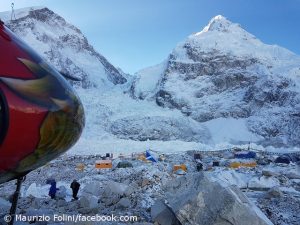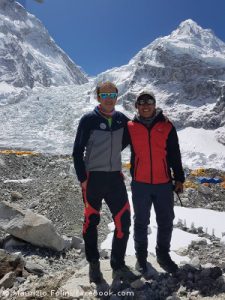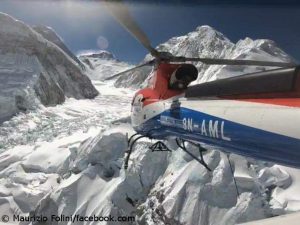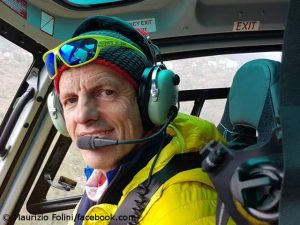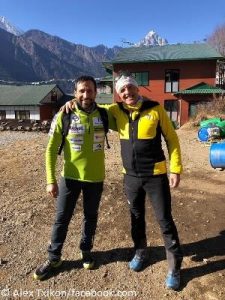Fight against fake rescue flights in Nepal
The air is getting thinner for those in Nepal who feather their beds with fake rescue flights. According to the Kathmandu-based newspaper “The Himalayan Times”, international insurance companies have set an ultimatum until 1 September to put an end to these illegal activities. Otherwise, they no longer want to cover the costs of helicopter rescue flights. The Nepalese government plans to set up a police unit in the Tourism Ministry that is to manage all rescues.
Not practicable
Lakpa Norbu Sherpa, who has been coordinating rescue on Mount Everest since 2003 as base camp manager of the Himalayan Rescue Association (HRA), is sceptical. “Police officers are no specialists”, tells me the 37-year-old, who was trained as a helicopter rescuer in Switzerland in 2012. Similar comments are made by Maurizio Folini: “The solution is not practicable. The police have no idea how to save people in the mountains.” The 53-year-old helicopter pilot from Italy is a pioneer for rescue flights on the eight-thousanders in Nepal. Since 2011 Folini has been flying regularly on the highest mountains in the world, in 2013 he managed the highest longline helicopter rescue of all time when he brought down a Nepalese climber from 7,800 meter on Everest.
Tip of the iceberg
He repeatedly pointed out that many of the rescue flights declared in Nepal in recent years were in fact none at all, Maurizio says to me: “But as a pilot you have little influence there. Last spring I refused such flights. I only flew when I had real patients on board.” An investigation commission of the Nepalese Ministry of Tourism has meanwhile named eleven companies from the helicopter and trekking industry and four hospitals in Kathmandu that allegedly defrauded insurance companies. But this should only be the tip of the iceberg.
Baking soda mixed into food
Mountain tourists are said to have been urged to get on the rescue helicopters even when they were slightly unwell. The Commission even reports of individual cases where local guides mixed baking soda as a laxative into food to provoke diarrhea and then persuaded their clients to return to Kathmandu on a rescue flight. Helicopters have been packed with several sick people, it said. However, the companies cashed it up with the insurance companies as several individual flights of the patients.
Three times higher invoice
Folini points out that most of the fake rescue flights start on the trekking routes, for example in Gorak Shep, the last settlement before Everest Base Camp, or in the Gokyo Valley, a popular trekking destination near the highest mountain on earth. “Trekking tourists or mountaineers are influenced by the agencies,” says Maurizio Folini. “The business is made by the agencies that invoice three times more than the real amount, 12,000 instead of 4,000 dollars per rescue.” According to Maurizio, some hospitals in Kathmandu also have “dirty fingers”. Many of the patients suffering from high altitude sickness who are now flown directly to the capital could just as easily be treated in the clinic in Lhukla, the gateway to the Everest region, he says.
Only half of the helicopters needed
According to the government commission, more than 1,300 helicopter rescues were reported in the first five months of 2018, causing insurance costs of more than 6.5 million dollars. “The biggest business for the helicopter companies is fake rescue,” says Folini. He suggests a kind of “filter” to get a grip on the problem: “We need a checkpoint like we already have in Everest Base Camp with the HRA. A doctor has to confirm that the helicopter transport is really necessary.” Maurizio believes that if the fake rescue flights were to disappear, half of the helicopters would be enough: “That would also be good for tourism in the Everest region. There’s too much flying now. You can hardly hike in the Khumbu without being disturbed by flight noise.”
Grievances also in the Alps
However, Folini warns against seeing the problem only through Western glasses. “Also in the Alps not everything is great,” says Maurizio, referring to prestigious mountains such as Mont Blanc or the Matterhorn, where much more people are climbing than on Everest and where, for example, the faeces problem is unsolved: “On Mont Blanc, the waste from the toilets often ends up on the glacier. And try to climb the Matterhorn without stepping into a pile!” Even in the Alps, not every helicopter flight is a “clean rescue”, says the experienced pilot, who has completed more than 14,000 flight hours since 1993. “Rescue is always business. How can we point a finger at a poor country like Nepal if we can’t solve our own problems at home?”



